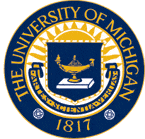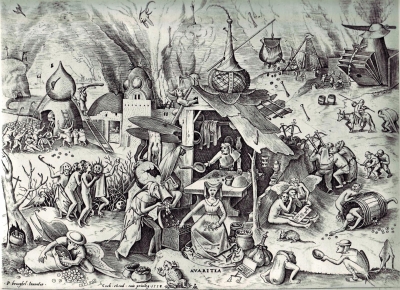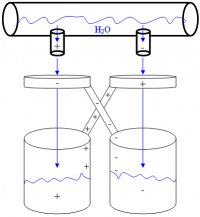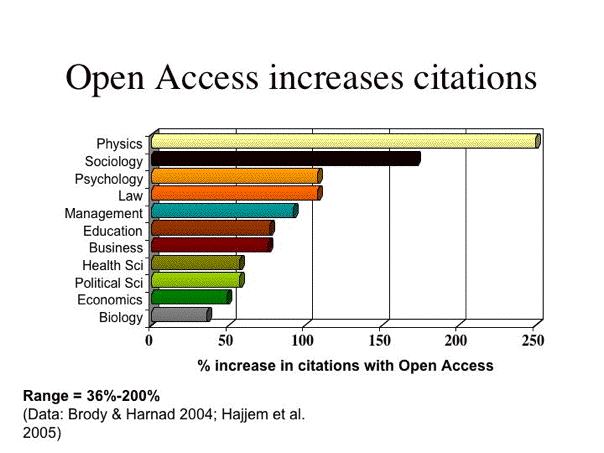Thursday, December 27. 2007
 The US NIH Green OA Self-Archiving Mandate was made law on December 26 2007 The US NIH Green OA Self-Archiving Mandate was made law on December 26 2007
Worldwide, that now makes 21 funder mandates, 11 institutional mandates, and 3 departmental mandates, plus 5 proposed funder mandates, 1 proposed institutional mandate, and 2 proposed multi-institutional mandates -- a total of 35 mandates already adopted and 8 more proposed so far. See ROARMAP.
2008 will now be the year of institutional Green OA self-archiving mandates. Research funder mandates cover funded research output in the funder's field. Institutional mandates cover all of research output, across all fields and nations.
The optimal way for funder and institutional mandates to complement one another and to ensure that mandates swiftly and systematically scale up to encompass all of research output worldwide is for both kinds of mandates to require deposit directly in the researcher's own Institutional Repository. Central Repositories, indexers, and search engines can then harvest from the distributed network of OAI-interoperable Institutional Repositories.
Stevan Harnad
American Scientist Open Access Forum
Sunday, December 23. 2007
  University of Michigan’s digital repository now available through PubMed University of Michigan’s digital repository now available through PubMed:
" Researchers who find articles by University of Michigan (UM) authors in PubMed can now directly -- and for free -- link to the full text using Deep Blue, UM’s digital repository, via PubMed’s LinkOut feature. Deep Blue is an online archive that preserves and provides access to UM intellectual and creative work. It is the first institutional repository to provide such links."
Congratulations to the University of Michigan and PubMed for adding this excellent and timely feature (to both PubMed and Michigan's Institutional Repository [IR], Deep Blue)! But why stop there?
The implications are obvious: Central Repositories [CRs] (like PubMed Central and Arxiv and CogPrints) should not be deposited in directly, because that merely complicates and competes with a systematic worldwide policy of depositing all institutional research output in each institution's own, OAI-compliant IR. Institutions are the primary research providers. They have the greatest stake in ensuring that all their own research output is maximally visible, accessible, and usable, thereby maximizing the institution's research impact. Institutions are also the best placed to showcase, monitor and reward the self-archiving of their own research output.
All institutions should mandate that all their research article output must be deposited in their own IR. Research funders (like NIH) should also mandate that all the research article output from the research they fund must be deposited in the fundee's own institution's IR.
Then CRs like PubMed Central as well as indexers like PubMed (or Thompson ISI or Scopus or Google Scholar) can either link to or harvest from the network of interoperable, OAI-compliant IRs.
In this natural way -- "deposit institutionally, harvest centrally" -- all of research output can be systematically made OA. Instead depositing willy-nilly in IRs or CRs will only create confusion and resistance on the part of researchers, who will understandably only wish to do the keystrokes once.
IR software can also help with automatic exports to other OAI-compliant sites where desired, as well as with version control.
Now that the NIH OA self-archiving mandate is imminent, it is all the more important to reformulate it in a way that will scale systematically to all research output worldwide, in all disciplines, rather than leaving it as one non-scaling special case for NIH-funded biomedical research.
And remember that the Web era means distributed content provision and central harvesting, Google-style. It is not, as in paper days, that all the content needs to go in one central physical space. Swan, A., Needham, P., Probets, S., Muir, A., Oppenheim, C., O’Brien, A., Hardy, R., Rowland, F. and Brown, S. (2005) Developing a model for e-prints and open access journal content in UK further and higher education. Learned Publishing 18 (1). pp. 25-40.
Abstract: A study carried out for the UK Joint Information Systems Committee examined models for the provision of access to material in institutional and subject-based archives and in open access journals. Their relative merits were considered, addressing not only technical concerns but also how e-print provision (by authors) can be achieved – an essential factor for an effective e-print delivery service (for users). A "harvesting" model is recommended, where the metadata of articles deposited in distributed archives are harvested, stored and enhanced by a national service. This model has major advantages over the alternatives of a national centralized service or a completely decentralized one. Options for the implementation of a service based on the harvesting model are presented. Stevan Harnad
American Scientist Open Access Forum
 On Sun, 23 Dec 2007, [anonymous] wrote:
Dear Father Christmas, On Sun, 23 Dec 2007, [anonymous] wrote:
Dear Father Christmas,
My wish goes towards allowing any researcher free access to current scientific information -- and when I say free, I mean without any constraint of fees, subscription, copyright. And what would be better than having open archives/repositories?
But I know this is pure utopia.
Even you, Father Xmas, are you on Open Access?
Since you are a creation of human intellect, someone must have an exclusive copyright on you, so is it even allowed to quote you without permission?
How to get out of this dilemma? Recently, in France and Germany, lawmakers wrote a new law, punishing anybody intending to infringe copyright with enormous fines...
My fellow European scientists are afraid and no longer dare to express their ideas. Father Xmas, give us some suggestions to be discussed in our Forum, but do not tell anybody else: we don't want to be prosecuted...
REPLY FROM FATHER XMAS, NORTH POLE:
Dear little boys and girls everywhere who yearn for Open Access:
Yes, there is a way that you can have the Open Access you say you so fervently desire. But Father Christmas cannot give it to you, any more than Father Christmas can give you big muscles, if that is what you yearn for. All Father Christmas can do is tell you how you yourselves can build the big muscles you desire (by exercising daily with increasing weights). And for Open Access it is exactly the same: It depends entirely on you, dear children, each and every one of you.
Nor can you build big muscles from one day to the other. If you try to lift too heavy a weight, too early, you only cause yourself muscle strain. So don't insist on too much overnight. Start with one simple fact that is easy to assimilate: There is nothing whatsoever -- nothing physical, nothing legal -- that prevents you from depositing your own final, peer-reviewed drafts (postprints) of every single one of your own current research journal articles in an OAI-compliant Institutional Repository, right now: Nothing. Not copyright law. Not technology. Not cost. Not expertise. No point in writing to Father Christmas to wish for that, because it is already entirely in your own hands:
Your institution has no Institutional Repository yet? Then, for the time being, deposit your postprints in a central repository, like CogPrints or Depot or Arxiv or HAL or PubMed Central. But do the deposit now.
The journal in which it is published does not yet endorse immediate OA self-archiving? Then, for the time being, set access to the deposit as Closed Access rather than Open Access for as long as the journal embargoes access. But do the deposit now. That's all. If all the little boys and girls did that before Christmas this year, on Christmas day all the current research worldwide would be visible worldwide, 62% of it already Open Access (because 62% of journals already endorse immediate OA self-archiving).
For the remaining 38% deposited in Closed Access, the metadata (author, title, journalname, date etc.) would be immediately visible worldwide, so any user who wanted to access the full-text could immediately email the author to request an eprint by email. That is not immediate 100% OA, but it is almost-immediate, almost-OA. Many Repositories already have a button whereby eprints can be requested and emailed semi-automatically: one keystroke from the requester, one keystroke from the author.
If all of you deposited all your current postprints before Christmas, boys and girls, all Repositories would soon have that button. And the growth of the OA muscles in this way, worldwide, keystroke by keystroke, would soon hasten the natural and well-deserved death of the remaining publisher-embargoes. (Yes, dear children, it is within the spirit of Christmas to speak about the "death" of evil things, such as plagues, hunger, war, injustice, and research access embargoes!)
So, dear little boys and girls, there are some things for which wishing or writing a letter to Santa Claus is not quite enough. Time to start exercising your little fingers. And if you find doing the keystrokes for depositing all your current articles before Christmas too low an ergonomic priority as long as it remains voluntary -- first, congratulations for having published so much at such a young age!
And second, instead of just writing to St. Nick, I suggest writing to the Principal, Rector, Vice-Chancellor or Provost of your school, to make known to them your fervent desire for OA, pointing out also your faintness of will about doing the keystrokes voluntarily as long as you feel you would be doing those dactylographics alone. Father Christmas's elves understand that as little researchers, you are already so busy and overloaded that you cannot steal the time to exercise your fingers in this way while your school gives you so much other homework to do if your other school-mates are not required to do it too.
So if you all write to your Principal asking that the school itself should make this digital muscle-building part of its standard athletic curriculum for all its pupils -- making the keystrokes mandatory for all of you -- then that mandate will ensure OA self-archiving its proper place in your hierarchy of priorities. The rewards will be felt in your year-end marks (if you don't mind Father Christmas talking about such unpleasant matters at a time we should be thinking of toys rather than toil!), because self-archiving builds the citations as surely as it builds muscles.
So don't worry about reforming copyright law. Copyright law is just the Cheshire Cat's grin, suspended in thin air, without you. It will reform itself in due course, if you just do what is already in your own hands (and always has been, ever since the dawn of the online era), right now, on the night before Xmas 2008. Carr, L. and Harnad, S. (2005) Keystroke Economy: A Study of the Time and Effort Involved in Self-Archiving.
"Optimizing OA Self-Archiving Mandates: What? Where? When? Why? How?" Your faithful old
Kris Kringle
Friday, December 21. 2007
 This is from your greedy, never-satisfied Archivangelist:
Now that the NIH Green OA Self-Archiving Mandate looks as if it will shortly be signed into Law:
(1) There is no need to wait to implement the NIH mandate
(2) There is no need to ape it: It can easily be optimised
(3) There is no need to reserve Green OA self-archiving for NIH-funded biomedical research
(4) All universities should mandate that all their research articles in all their disciplines are self-archived
(5) There is no need to self-archive all those articles in PubMed Central: They should be self-archived in each university's own Institutional Repository
(6) There is no need to allow deposit to be embargoed for 12 months: Deposit should be mandated immediately upon acceptance for publication
(7) Embargoed deposits can be set as Closed Access during the embargo
(8) Meanwhile the Institutional Repository will allow users webwide to email the author a semi-automatic request for an eprint for individual use immediately for any deposit that is not yet OA.
This will provide either immediate OA ( 62%) or almost-immediate, almost-OA ( 38%) for all research articles in all disciplines, worldwide. It will also ensure the natural and well-deserved death of research access embargoes soon thereafter. Summary of how to optimize the Green OA Self-Archiving Mandate:
I. Universities mandate deposit in their own Institutional Repositories.
II. Deposit is mandated immediately upon acceptance for publication.
III. The permissible embargo applies to the date on which the deposit is set as OA, not to the day on which the deposit is made.
" Optimizing OA Self-Archiving Mandates: What? Where? When? Why? How?"
Stevan Harnad
American Scientist Open Access Forum
Tuesday, December 18. 2007
 In " Show me the data" Rossner, et al (2007, The Journal of Cell Biology, Vol. 179, No. 6, 1091-1092) wrote: "Just as scientists would not accept the findings in a scientific paper without seeing the primary data, so should they not rely on Thomson Scientific's impact factor, which is based on hidden data. As more publication and citation data become available to the public through services like PubMed, PubMed Central, and Google Scholar®, we hope that people will begin to develop their own metrics for assessing scientific quality rather than rely on an ill-defined and manifestly unscientific number." Rossner et al are quite right, and the optimal, inevitable solution is at hand: (1) All research institutions and research funders will mandate that all research journal articles published by their staff must be self-archived in their Open Access (OA) Institutional Repository.
(2) This will allow scientometric search engines such as Citebase (and others) to harvest their metadata, including their reference lists, and to calculate open, transparent research impact metrics.
The prospect of having Open Research Metrics for analysis and research assessment -- along with the prospect of maximizing research usage and impact through OA -- will motivate adopting the mandates, closing the autocatalytic circle of benefits from OA.
Brody, T., Carr, L., Gingras, Y., Hajjem, C., Harnad, S. and Swan, A. (2007) Incentivizing the Open Access Research Web: Publication-Archiving, Data-Archiving and Scientometrics. CTWatch Quarterly 3(3).
Harnad, S. (2007) Open Access Scientometrics and the UK Research Assessment Exercise. Proceedings of 11th Annual Meeting of the International Society for Scientometrics and Informetrics 11(1) : 27-33, Madrid, Spain. Torres-Salinas, D. and Moed, H. F., Eds.
Shadbolt, N., Brody, T., Carr, L. and Harnad, S. (2006) The Open Research Web: A Preview of the Optimal and the Inevitable, in Jacobs, N., Eds. Open Access: Key Strategic, Technical and Economic Aspects. Chandos.
Stevan Harnad
American Scientist Open Access Forum
Saturday, December 15. 2007
 Commentary on: "Putting Science into Science Publishing" by Joseph Esposito, Publishing Frontier (blog) December 11 2007. The posting contains the by now familiar litany of lapses:
(1) Open Access is not only -- nor even primarily -- about Open Access Publishing (Gold OA): It is about OA itself, which includes Green OA, the far bigger and faster-growing form of OA: Authors making their own published, peer-reviewed non-OA journal articles (not only or primarily their unpublished preprints) OA by self-archiving them in their own OA Institutional Repositories. Only 10% of journals are Gold OA, but over 90% of journals endorse immediate Green OA self-archiving by their authors -- with over 60% endorsing the immediate self-archiving of the author's final peer-reviewed draft.
(2) The question of whether librarians will cancel journals is not about Gold OA: It is about Green OA. Joseph Esposito contemplates whole-journal cancellations of subscriptions to Gold OA journals, whereas the speculations have been about whether and when librarians would cancel non-OA journals as Green OA self-archiving grows. Green OA self-archiving grows anarchically, not journal by journal. So not only is it hard for a librarian to determine whether and when all the articles in a given journal have become OA, but all the evidence (from the publishers) to date in the few areas (of physics) where Green OA self-archiving is already at or near 100% is that there are as yet no detectable cancellations as a result of 100% Green OA. (Rather, the publishers themselves seem to be adopting Gold OA in these areas: SCOAP3.)
(3) The OA citation impact advantage is not about unpublished or low-impact Gold OA journal articles versus high-impact non-OA journal articles: It is about the additional citation impact provided by OA, for any non-OA article, including those articles published in high impact journals! They don't lose their non-OA citations: they just gain further OA citations.  (4) The international, interdisciplinary survey evidence of Swan and Associates did not just tautologically confirm that people comply with requirements if required:
(4) The international, interdisciplinary survey evidence of Swan and Associates did not just tautologically confirm that people comply with requirements if required: The point was that over 95% of researchers report that they would comply with a Green OA self-archiving mandate from their employers or funders and 81% report they would do so willingly. (Only 14% said they would comply unwillingly, and 5% said they would not comply.) Arthur Sale's comparisons of actual mandates and compliance rates confirmed these findings, with spontaneous (unmandated) self-archiving rates hovering around 15%, encouraged self-archiving rates rising to about 30% and mandated, incentivized self-archiving rates approaching 100% within two years. (Not surprising, since academics are busy, and would be publishing much less too, if it were not for the existing universal publish-or-perish mandate.) Self-archiving is rewarded by the resulting enhanced research impact metrics, which their institutions also collect and credit, if researchers self-archive. [Added: see also Swan's rebuttal.]

In sum, OA is not about publishing, it is about maximizing research progress and impact. The outcome -- 100% OA -- is optimal and inevitable for research, researchers, their institutions, their funders, the vast R&D industry, and the tax-paying public.
Publishers need to adapt to the optimal and inevitable for research. Research is not conducted and reported in order to provide revenues to the publishing industry. The publishing industry is providing a value-added service -- which, in the online era is rapidly scaling down to just the management of peer review and the certification of its outcome: The peers review for free, the authors can generate and revise their electronic texts themselves, and their institutions can archive and provide access to the final, peer-reviewed drafts in their OA Institutional Repositories.
What is left of peer-reviewed journal publishing, then, is to implement the peer review itself, and to certify the outcome with the journal's name and track-record. For now, journals are still providing much more than that (paper edition, mark-up, PDF, distribution), in exchange for journal subscriptions, and as long there is still a market for all that, the publishing status quo remains.
If and when subscriptions should ever become unsustainable because of universal Green OA, journals can downsize and convert to Gold OA as SCOAP3 is already doing. But for now, it is up to the research community -- and the research community alone -- to hasten the transition to universal Green OA.
Stevan Harnad
American Scientist Open Access Forum
|









